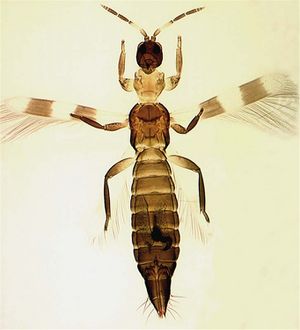Difference between revisions of "Aeolothrips collaris"
| Line 32: | Line 32: | ||
== Type information == | == Type information == | ||
| − | Syntypes | + | Syntypes (''A. collaris''), Senckenberg Museum, Frankfurt. |
| + | |||
| + | Lectotype female (''A. brevicinctus''), The Natural History Museum, London. | ||
| + | |||
| + | Lectotype female (''A. fulvicollis''), The Natural History Museum, London. | ||
[[category:Aeolothrips species]][[category:Aeolothripidae species]] | [[category:Aeolothrips species]][[category:Aeolothripidae species]] | ||
Revision as of 00:44, 8 April 2013
Nomenclatural details
Aeolothrips collaris Priesner, 1919: 119.
Aeolothrips fulvicollis Bagnall, 1919: 253. Synonymised by Mound, 1968: 9.
Aeolothrips perclarus Melis, 1932: 156.
Aeolothrips brevicinctus Bagnall, 1934: 125.
Aeolothrips palaestinensis Priesner, 1935: 318.
Aeolothrips meridionalis Priesner, 1948: 324. Synonymy in zur Strassen, 2003: 46.
Biology and Distribution
Widespread across Europe to Syria and Afghanistan.
References
Priesner H (1919) Zur Thysanopteren-Fauna Albaniens. Sitzungsberichte der Kaiserlichen Akademie der Wissenschaften 128: 115–144.
Bagnall RS (1919) Brief descriptions of new Thysanoptera X. Annals and Magazine of Natural History (9)4: 253–277.
Bagnall RS (1934) Contribution towards a knowledge of the genus Aeolothrips (Thysanoptera) with descriptions of new species. Entomologist's monthly Magazine 70: 120–127.
Priesner H (1935) Contributions towards a knowledge of the Thysanoptera of Egypt, X. Bulletin de la Societe Royale entomologique d'Egypte 19: 315–325.
Priesner H (1948) Contributions towards a knowledge of the Thysanoptera of Egypt, XIV. Bulletin de la Societe Royale entomologique d'Egypte 32: 317–341.
Mound LA (1968) A review of R.S. Bagnall's Thysanoptera collections. Bulletin of the British Museum (Natural History). Entomology Supplement 11: 1-181.
zur Strassen R (2003) Die terebranten Thysanopteren Europas und des Mittelmeer-Gebietes. Die Tierwelt Deutschlands 74: 1-271.
Type information
Syntypes (A. collaris), Senckenberg Museum, Frankfurt.
Lectotype female (A. brevicinctus), The Natural History Museum, London.
Lectotype female (A. fulvicollis), The Natural History Museum, London.
